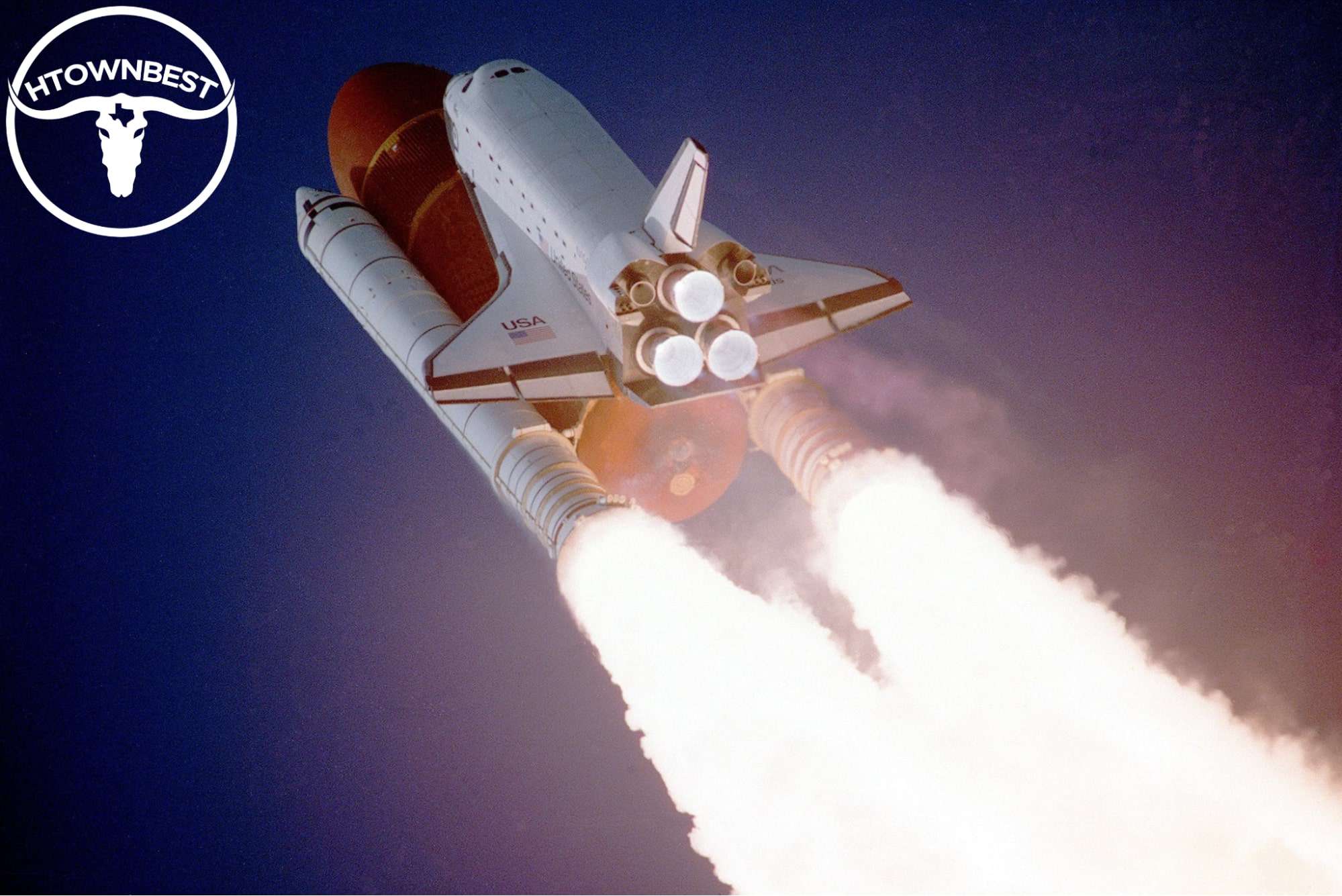Do rockets take off from houston? Here’s all you need to know.

- Why do people think rockets take off from Houston?
- Houston is Home to NASA's Johnson Space Center and Mission Control
- Houston Has Played an Important Role in Space History
- Houston’s Image as “Space City” in Media and Pop Culture
- Why is Mission Control in Houston?
- Houston’s Role as Ground Control
- Significant Rocket Launches with Houston as Ground Control
- Apollo 11
- Mars Rover missions
- Where do rockets actually take off from in the US?
- Why are rockets launched from Florida?
- Florida Is Located near the Equator
- Florida Has Favorable Weather Conditions
- Florida Has Access to the Ocean
Houston, we have a common misconception!
While Houston is home to NASA’s Johnson Space Center, rockets don’t actually launch from the city.
So why do so many people believe otherwise? Let’s find out!
Why do people think rockets take off from Houston?

Houston is a major hub for the aerospace and space exploration industries, and has a long history of launching rockets and sending spacecraft into space.
Although mission control for many space missions is located in Houston, the rockets are actually launched from the Kennedy Space Center in Florida. People think that rockets launch from Houston because it’s where NASA’s Johnson Space Center is located.
Houston is Home to NASA’s Johnson Space Center and Mission Control

The Lyndon B. Johnson Space Center (JSC) in Houston is the headquarters for NASA’s human spaceflight program. It’s one of the most recognizable and important space centers in the world!
Established in 1961, JSC has played a crucial role in the United States space program, serving as the primary center for human spaceflight activities.
The space center mainly trains astronauts and designs spacecraft. The center’s facilities include simulators, mockups, and other equipment that allow astronauts to practice various tasks and procedures in a realistic environment.
It has also played a crucial role from the early Mercury and Gemini missions to the Apollo moon landings and the Space Shuttle program.

Another reason why people might think rockets take off from Houston is because it is home to Mission Control – the hub for all spaceflight operations, including launch and landing activities.
It’s where flight controllers monitor the health and safety of astronauts in space, and where they make critical decisions about space missions in real-time.
Beyond its human spaceflight activities, JSC also conducts research in a variety of areas related to space exploration, including life sciences, astromaterials research, and planetary science.

The center also houses a number of exhibits and attractions, including the Space Center Houston visitor center, which features interactive exhibits and displays related to space exploration and the history of the U.S. space program.
One of the most popular attractions is the NASA Tram Tour, which takes visitors on a behind-the-scenes look at the JSC. The tour includes stops at the historic Mission Control Center, the astronaut training facility, and the Space Vehicle Mockup Facility.
Beyond its exhibits and attractions, Space Center Houston also offers a variety of educational programs and events, including camps, workshops, and lectures. Visitors can even meet real-life astronauts and hear about their experiences in space.
Houston Has Played an Important Role in Space History

Houston played a significant role in the early days of the U.S. space program, including the Apollo missions that landed astronauts on the moon.
Houston’s role in the U.S. space program began in the 1960s with the establishment of the Manned Spacecraft Center.
The center was responsible for developing the spacecraft and technology that would eventually land humans on the moon, as well as conducting astronaut training and mission control for spaceflights.
During the Apollo program, which ran from 1961 to 1975, Houston served as the hub of the U.S. space program.
It was here that NASA’s Mission Control Center oversaw all of the Apollo missions, including the famous Apollo 11 mission that landed the first humans on the moon in 1969.
Houston’s Image as “Space City” in Media and Pop Culture

Houston is often referred to as the “Space City,” a nickname that has helped to spread the misconception that rockets launch from the city.
The nickname was first used in the 1960s as Houston emerged as a hub for the U.S. space program, and it has since become synonymous with the city’s association with spaceflight.
Media representation and pop culture have played a significant role in shaping public perceptions of spaceflight. Houston’s role in the U.S. space program has been featured prominently in movies, TV shows, and news outlets.

One of the most famous examples of this is the movie “Apollo 13,” which dramatizes the events of the ill-fated mission of the same name.
In the movie, the iconic line “Houston, we have a problem” is spoken by astronaut Jim Lovell as he and his crewmates face a life-threatening emergency in space.
The scene, which takes place in the mission control center in Houston, has become synonymous with the U.S. space program and is often referenced in popular culture.
The city has been referenced in numerous songs, TV shows, and movies, often in connection with spaceflight. For example, the song “Space Cowboy” by Steve Miller Band includes the line “Houston, you’ve got a problem.”
Why is Mission Control in Houston?

Houston was chosen as the site for NASA’s Manned Spacecraft Center in 1961 for its large technical workforce, research universities, airport, and cultural attractions that made it easier for staff working to live there permanently.
Although Tampa, Florida, emerged as the most favorable candidate, Houston eventually won out, with Texas politicians playing a role in the decision.
The location for the new center was 25 miles southeast of downtown Houston on the north shore of Clear Lake on 1,000 acres of land Rice University made available to NASA.
The $60 million center would serve as the center of America’s spaceflight program, including a new Mission Control Center, training facilities for astronauts, facilities for testing spacecraft for the extreme environment of spaceflight, offices, and laboratories.
Other criteria for a suitable site included the following:
- Barge transportation in ice-free waters
- A mild climate
- All-weather commercial jet service
- A nearby Department of Defense air base
- A nearby university
- At least 1,000 acres of land
- Property that could be acquired at a reasonable cost.
NASA evaluated 23 cities and selected three finalists, including Tampa, Houston, and San Francisco. Houston was ultimately chosen since it fulfilled most of the conditions necessary.
Houston’s Role as Ground Control

One of the primary functions of the Lyndon B. Space Center is to serve as the primary ground control center for rocket launches.
During a rocket launch, the flight controllers monitor and control all aspects of the launch, from liftoff to orbital insertion. They communicate with the astronauts on board the spacecraft, as well as with other NASA centers and international partners.
The ground control team in Houston is responsible for ensuring the safety of the crew, the spacecraft, and the launch site.
They monitor the rocket’s trajectory and adjust it as necessary to keep it on course, and they keep a close eye on the rocket’s systems to ensure that everything is functioning properly.
Significant Rocket Launches with Houston as Ground Control
Apollo 11

Apollo 11 was the historic mission that landed the first humans on the Moon in 1969. The mission itself was controlled and monitored from NASA’s mission control center in Houston, Texas.
Houston’s role in the Apollo 11 mission was crucial. The JSC was responsible for training the astronauts, designing and building the spacecraft, and overseeing the mission operations.

NASA’s mission control center in Houston was responsible for monitoring the astronauts’ vital signs, tracking the spacecraft’s trajectory, and coordinating with the crew throughout the entire mission.
One of the most iconic moments of the Apollo 11 mission was the famous words spoken by astronaut Neil Armstrong as he became the first human to set foot on the Moon.
These words, “That’s one small step for man, one giant leap for mankind,” were actually broadcast to the world from Houston’s mission control center!
Mars Rover missions

The NASA Johnson Space Center in Houston is home to the Mars Rover Operations team, which is responsible for overseeing the project.
There have been several Mars rover missions, including the Spirit, Opportunity, and Curiosity rovers, which have made significant discoveries on the Martian surface.
The mission control team in Houston is responsible for communicating with the Mars rovers, sending commands, and receiving data. The team also monitors the health and status of the rovers and troubleshoots any issues that arise during the mission.
Where do rockets actually take off from in the US?

In the US, rockets take off from several launch sites located around the country.
One of the most well-known launch sites is the Kennedy Space Center in Florida, which is operated by NASA. It has been used for numerous manned and unmanned space missions, including the Apollo moon landings and the space shuttle program.
Another launch site used by NASA is the Wallops Flight Facility in Virginia, which is used primarily for launching scientific satellites and research missions.
SpaceX, on the other hand, has its primary launch site located at the Cape Canaveral Space Force Station in Florida, which is adjacent to the Kennedy Space Center and about a four-hour drive from Houston.
Other launch sites in the US include Vandenberg Air Force Base in California, which is primarily used for launches into polar orbits, and the Mid-Atlantic Regional Spaceport in Virginia, which is used for commercial and government launches.
While Houston may not be a launch site for rockets, it’s in close proximity to several launch sites, which may contribute to the misconception that rockets take off from the city.
Why are rockets launched from Florida?
Florida Is Located near the Equator

Florida’s proximity to the equator is one of the key reasons why it’s an ideal location for rocket launches.
The Earth rotates at a speed of approximately 1,000 miles per hour at the equator, which means that objects launched from the equator already have a significant boost in speed compared to those launched from higher latitudes.
This boost in speed has a significant impact on the amount of fuel needed for a rocket launch. Rockets need to reach a certain velocity, known as escape velocity, in order to break free of the Earth’s gravitational pull and enter orbit.
By launching from a location closer to the equator, rockets can take advantage of the additional speed provided by the Earth’s rotation, which reduces the amount of fuel needed to reach escape velocity.
Florida Has Favorable Weather Conditions

Florida has warm temperatures year-round and relatively low temperature variations. This means that rockets can be launched in Florida at any time of the year, without the need for weather-related delays or cancellations.
Florida also has relatively low humidity levels, which is an important consideration for rocket launches. High humidity can cause problems for rockets because of condensation and icing on rocket components.
While the state does experience occasional hurricanes and thunderstorms, these events are relatively rare and can usually be predicted well in advance. This means that rocket launches can be scheduled and planned with greater confidence.
Florida Has Access to the Ocean

Florida’s location on the east coast of the United States is an additional advantage when it comes to rocket launches.
The state’s eastern coast provides a vast expanse of open water over the Atlantic Ocean, which is particularly important for launches involving larger rockets or heavier payloads.
In the event of a launch accident, the open area over the Atlantic Ocean provides a safety buffer zone, as any debris can safely fall into the ocean without posing a threat to populated areas.
This minimizes the risk of damage or injury from falling debris and ensures that any potential accidents are contained within a safe and controlled area.





